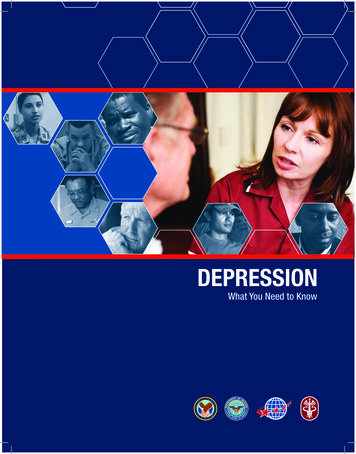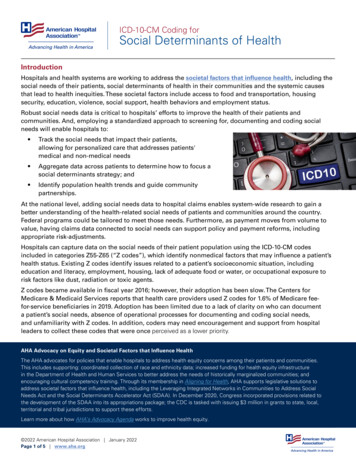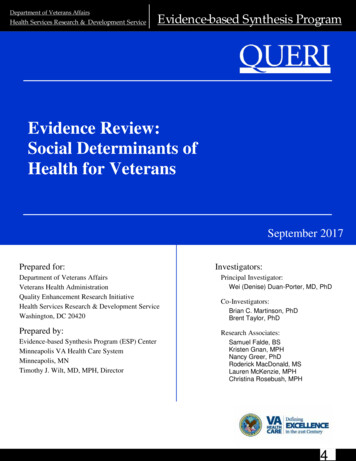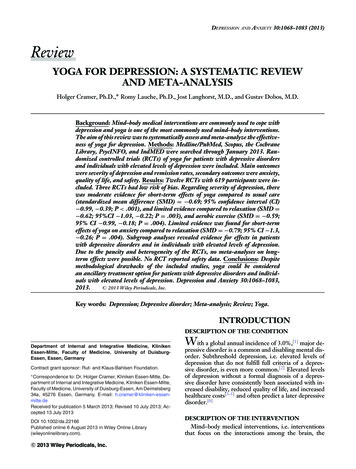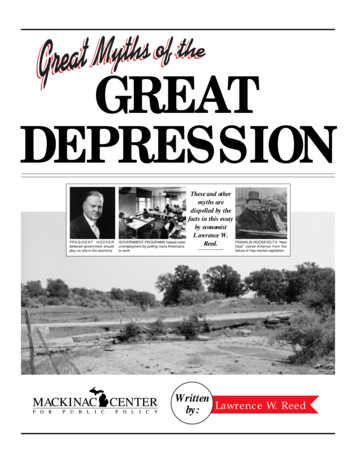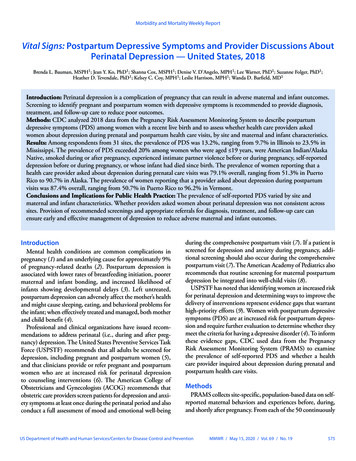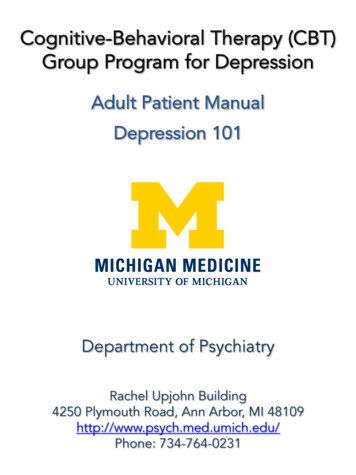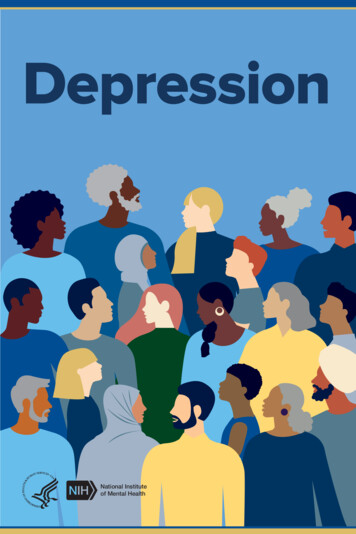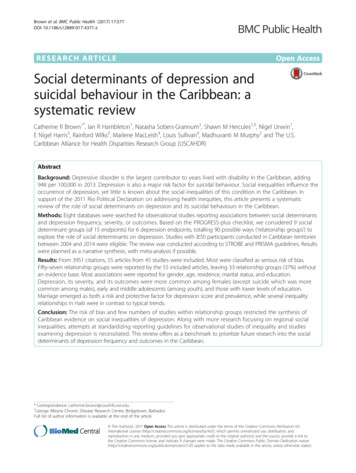
Transcription
Brown et al. BMC Public Health (2017) 17:577DOI 10.1186/s12889-017-4371-zRESEARCH ARTICLEOpen AccessSocial determinants of depression andsuicidal behaviour in the Caribbean: asystematic reviewCatherine R Brown1*, Ian R Hambleton1, Natasha Sobers-Grannum2, Shawn M Hercules1,5, Nigel Unwin1,E Nigel Harris3, Rainford Wilks3, Marlene MacLeish4, Louis Sullivan4, Madhuvanti M Murphy2 and The U.S.Caribbean Alliance for Health Disparities Research Group (USCAHDR)AbstractBackground: Depressive disorder is the largest contributor to years lived with disability in the Caribbean, adding948 per 100,000 in 2013. Depression is also a major risk factor for suicidal behaviour. Social inequalities influence theoccurrence of depression, yet little is known about the social inequalities of this condition in the Caribbean. Insupport of the 2011 Rio Political Declaration on addressing health inequities, this article presents a systematicreview of the role of social determinants on depression and its suicidal behaviours in the Caribbean.Methods: Eight databases were searched for observational studies reporting associations between social determinantsand depression frequency, severity, or outcomes. Based on the PROGRESS-plus checklist, we considered 9 socialdeterminant groups (of 15 endpoints) for 6 depression endpoints, totalling 90 possible ways (‘relationship groups’) toexplore the role of social determinants on depression. Studies with 50 participants conducted in Caribbean territoriesbetween 2004 and 2014 were eligible. The review was conducted according to STROBE and PRISMA guidelines. Resultswere planned as a narrative synthesis, with meta-analysis if possible.Results: From 3951 citations, 55 articles from 45 studies were included. Most were classified as serious risk of bias.Fifty-seven relationship groups were reported by the 55 included articles, leaving 33 relationship groups (37%) withoutan evidence base. Most associations were reported for gender, age, residence, marital status, and education.Depression, its severity, and its outcomes were more common among females (except suicide which was morecommon among males), early and middle adolescents (among youth), and those with lower levels of education.Marriage emerged as both a risk and protective factor for depression score and prevalence, while several inequalityrelationships in Haiti were in contrast to typical trends.Conclusion: The risk of bias and few numbers of studies within relationship groups restricted the synthesis ofCaribbean evidence on social inequalities of depression. Along with more research focusing on regional socialinequalities, attempts at standardizing reporting guidelines for observational studies of inequality and studiesexamining depression is necessitated. This review offers as a benchmark to prioritize future research into the socialdeterminants of depression frequency and outcomes in the Caribbean.* Correspondence: catherine.brown@cavehill.uwi.edu1George Alleyne Chronic Disease Research Centre, Bridgetown, BarbadosFull list of author information is available at the end of the article The Author(s). 2017 Open Access This article is distributed under the terms of the Creative Commons Attribution 4.0International License (http://creativecommons.org/licenses/by/4.0/), which permits unrestricted use, distribution, andreproduction in any medium, provided you give appropriate credit to the original author(s) and the source, provide a link tothe Creative Commons license, and indicate if changes were made. The Creative Commons Public Domain Dedication o/1.0/) applies to the data made available in this article, unless otherwise stated.
Brown et al. BMC Public Health (2017) 17:577BackgroundThe Global Burden of Disease study has ranked depressive disorders as the largest contributor to years livedwith disability (YLD) in the Caribbean since 1990, withthese conditions adding 948 YLD per 100,000 in 2013[1, 2]. Among 15–49 year olds, this represents 10% of allYLD [1, 2]. Suicide, a last-resort outcome of depression,occurs at a global rate of 11.4 per 100,000, thoughstigma-associated underreporting underestimates thetrue value [3]. While suicide represents the second leading cause of death among 15–29 year olds globally, animportant risk factor such as depression often goes undiagnosed or untreated [3]. Even more, undiagnosed oruntreated depression is a risk factor for increased adverseoutcomes of many chronic and acute illnesses [4–8].Social experiences throughout the life course influencethe occurrence of depressive disorders and subsequent adverse outcomes [9]. For instance, income inequality, particularly in wealthy countries, is associated with a higherprevalence of mental disorders, and the degree of socioeconomic disadvantage is proportionate to the risk of developing such a disorder [10]. Moreover, when socioeconomicinequalities are perpetuated through generations, inequalities are further entrenched in depressive disorders overtime [10]. Examining whether there are differences amongparticular groups, and determining their basis, can guidepolicy towards improving outcomes. The World HealthOrganization (WHO) Commission on the Social Determinants of Health (CSDH) has highlighted the role of healthresearch in understanding health inequalities and inequities,and through the 2011 Rio Political Declaration, countrieshave committed to monitoring, understanding and addressing health inequities [11, 12].Globally, research on social determinants of depression and its outcomes is limited mostly to primary studies. Observational studies from India, USA, UK, andEurope report that older age, female gender, lower education, and poor economic status are associated with depression [13–17]. However, systematic reviews arelimited in scope as they tend to focus narrowly on economic disadvantage, showing that the poor and disadvantaged suffer disproportionately from common mentaldisorders and their adverse consequences [9, 18–20].Other social determinants as well as other regions warrant exploration to illustrate whether regional orcountry-level contexts have a role to play [9]. To date,there has been no published systematic assessment ofevidence on the social determinants of depressionamong Caribbean populations. This systematic review isguided by the analytical framework used to examine thesocial determinants of specific conditions by the WHOCSDH [21]. This review uses a simplified version of theframework to answer the primary research question:what is the distribution, by known social determinantsPage 2 of 11of health, of the frequency, severity, and adverse outcomes of depression among populations living in theCaribbean?MethodsFull details of the review methodology are available inthe study protocol (see Additional file 1). The protocolwas guided by an initial scoping review of depression, aprevious systematic review of social determinants of diabetes [22], and concurrent systematic reviews of breastand prostate cancer.Eligibility criteriaObservational studies of any design were sought that reported relationships between a social determinant and depression frequency (incidence, prevalence), depressionseverity (score on any depression scale) or depression outcomes (suicide ideation, parasuicide, suicide). These particular outcomes were selected based on an initial scopingreview of depression which showed a majority of researchto examine these variables. Articles published betweenJanuary 2004 and December 2014 in the dominant Caribbean languages (English, Spanish, French, and Dutch)were sought from 32 Caribbean territories. This 10-yearperiod was selected as the study is taking place within thecontext of a major review of regional and national policyresponses in the Caribbean to chronic non-communicablediseases [23]; therefore the findings have relevance to thecurrent situation and could inform policy response.Included studies drew upon samples from either thegeneral population or healthcare facility catchments.Age restrictions were not used, but sample sizes 50were excluded as unlikely to be fully representative ofunderlying populations. The selection of social determinants was guided by the extension of the PRISMA statement for the transparent reporting of systematic reviewsand meta-analyses with a focus on health equity, whichrecommends the “PROGRESS-Plus” checklist [24]. Thisacronym checklist refers to a core list of social determinants, namely: place of residence, race or ethnicity (alternatively culture or language), occupation, gender,religion, education, socio-economic position (SEP), social capital, plus other social determinants that might beof interest [24]. For this study, ‘age’ was included a ‘Plus’to this listing.Search strategy, study selection, data extractionThe databases searched were: MEDLINE (via Pubmed);EMBASE (via Ovid); SciELO; PsycInfo (via EBSCO);CINAHL (via EBSCO); CUMED, LILACS, and IBECS(via WHO Virtual Health Library) [25–30]. The finalsearch was conducted in February 2015. The searchstrategies are detailed in a supplementary file (see
Brown et al. BMC Public Health (2017) 17:577Additional file 2). Search results were maintained inEndnote reference manager software [31].Study selection and data abstraction were undertakenin duplicate by two independent reviewers (CRB, SMH);any inconsistencies were resolved by a third reviewer(MMM). Study selection was conducted in two stages.First, titles and abstracts were screened to identify potentially relevant articles; second, full-text screening ofpotentially relevant articles was conducted to identify articles for inclusion in the review. If inadequate information was available for decision-making in the first stage,the article automatically progressed to full-text review.In addition to those excluded, 8 articles were either inaccessible or awaiting publication [32–39]. With guidance by the STROBE statement on strengthening thereporting of observational studies in epidemiology andthe PRISMA-Equity statement [40, 41], an electronicdata abstraction form was created in REDCap database[42] (see Additional file 1).Risk of bias assessmentRisk of bias was assessed according a tool adapted fromSTROBE and Cochrane ACROBAT-NRSi guidelines (seeAdditional file 1) [40, 43]. Bias was assessed in 5 domains at the relationship level: confounding (was controlfor known and potential confounders adequate?), participant selection (is the sample representative of the targetpopulation?), missing data (is the data reasonablycomplete?), outcome measurement (is a social determinant or disease endpoint appropriately measured?), selective reporting (is a relationship selectively reported?).Studies were classified as having serious, moderate, low,or unclear risk of bias. To accommodate the differenttools and methods used to identify depressive disorders,the use of a validated tool and the involvement of clinical expertise were considered to be necessary featuresof the screening process. If a measurement tool was notvalidated or if a clinician was not involved in the screening, the relationship was classified as “high-risk” underthe outcome measurement domain. Two reviewers(CRB, MMM) made an independent judgement on theoverall risk of bias of each included article, consideringequal importance of each domain and the likely direction and magnitude of the bias from each domain. Discrepancies were discussed by the two reviewers toachieve consensus.Synthesis of resultsThe review was planned as a narrative synthesis with supplementary meta-analysis if possible. Key study details arepresented, followed by a description of each associationbetween a social determinant and either a measure of depression frequency, severity, or outcome. The number andtype of inequality relationships were summarized in anPage 3 of 11‘evidence gap map’ – a visual tool to highlight the currentevidence on the social determinants of depressive disorders in the Caribbean and as a guide for focusing futureresearch [44] Given the methodological heterogeneity ofthe study settings and their measurement tools, metaanalysis was not conducted.ResultsSummary of included studiesFigure 1 presents a flowchart of articles identified, excluded, and included. Additional file 3: Table S1 describescharacteristics of the 55 included articles, from 45 uniquestudies which examined one or more inequality relationships. Of these 55 articles, 29 reported on depression frequency, 15 reported on depression severity, and 18reported on depression outcomes (12 articles overlappedexamining measures from two endpoint groups). A totalof 15 social determinants were examined. Depression frequency was reported as a prevalence in all articles. Studieswere conducted in English-speaking (Bahamas, Barbados,Grenada, Guyana, Jamaica, St. Kitts & Nevis, St. Lucia, St.Vincent, Trinidad and Tobago); French-speaking (Haiti,Martinique); Spanish-speaking (Cuba, Dominican Republic, Puerto Rico); and Dutch-speaking (Suriname) Caribbean territories. Majority of articles originated from Cuba(n 15) and Jamaica (n 15).Figure 2 illustrates the distribution of inequality relationships among the included articles. Across the ninecategories of social determinants, there were a total of15 social determinants and 6 review endpoints, totalling90 inequality relationship groups that could have beenreported. Fifty-seven (63%) of these relationship groupswere reported by the 55 included articles, leaving 33 relationship groups (37%) without an evidence base. Therewere 222 inequality relationships reported: 86 on depression frequency, 15 on depression severity, and 121 ondepression outcomes. When articles reporting data fromsame study were considered and removed, the numberof inequality relationships fell to 214: 82 reporting depression frequency, 13 reporting depression severity, and119 reporting depression outcomes. While most relationship groups were explored, the quantity of inequalityrelationships within each group was limited.Risk of bias of included studiesA summary of the overall risk of bias classificationassigned to each of the 55 articles is presented in Additional file 4: Table S2. Classifications specific to each article in each of the five domains are described in anextended table, Additional file 5: Table S3. Of the 55 articles, 11 were classified as moderate-risk, 31 were classifiedas serious-risk, 8 were classified as unclear-risk, 3 wereclassified as serious/moderate-risk, and 2 were classifiedas serious/unclear-risk. Figure 3 details the proportion of
Brown et al. BMC Public Health (2017) 17:577Page 4 of 11Fig. 1 Flowchart of search strategy and article selectionrelationship classifications within each of the risk of biasdomains. Overall, lack of adjustment for potential confounding was the main contributor to an increased risk ofbias, followed by non-disclosure or inadequate handling ofmissing data. This collective high risk of bias of the included studies must be taken into consideration wheninterpreting results.Results of inequality relationshipsThe amount of inequality relationships, stratified by social determinant, varied greatly – from 61 examininggender, to 1 examining crowding. The results of the social determinants which contributed the most relationships – gender, age, residence, marital status, andeducation - are detailed below. Descriptions for theremaining social determinants are located in a supplementary file, Additional file 6.GenderGender was examined in 61 inequality relationships (58unique) across 47 articles: depression prevalence(n 23), depression score (n 11), suicidal ideation(n 7), parasuicide (n 12), suicide (n 8). Amongthese, 12 were classified as having moderate risk of bias,38 as having serious risk of bias, and 11 as havingunclear risk of bias. Across depression prevalence, depression score, suicidal ideation and parasuicide, femalesoutnumbered males with only minor exceptions: onestudy from Haiti found a slightly higher prevalence (92%vs 86.5%) and depression scores (x 23.4 vs x 21.1)among males [45]; and three studies showed slightlymore parasuicide in males in Martinique and PuertoRico [46, 47, 48]. Suicide, however, unanimously occurred more frequently by males across several countries[49–56].AgeAge was examined in 32 inequality relationships across26 articles: depression prevalence (n 11), depressionscore (n 3), suicidal ideation (n 5), parasuicide(n 8), suicide (n 5). Among these, 10 were classifiedas having moderate risk of bias, 17 as having serious riskof bias, and 5 as having unclear risk of bias. Of thosestudies examining depression in adolescents specifically,most found the highest prevalence and depression scoresamong 16 and 17 year olds [57–60]. However, suicidalideation and parasuicide were more prevalent amongyounger adolescents aged 16 years than those older[46, 48, 61, 62]. Adult studies examining depressionprevalence reported varied results, but the single adult
Brown et al. BMC Public Health (2017) 17:577Page 5 of 11Fig. 2 Summary of 214 unique inequality relationships among 55 included articles [45–86, 99, 100–111]study examining depression score found older age to beassociated with increased scores for both genders inHaiti [63]. The sole adult study examining suicidal ideation in adults found Puerto Ricans aged 50 years to bemore likely to perform this than those aged 64 years(OR 1.71, 95%CI 1.39–2.65) [48]. Lower rates of parasuicide and suicide were also reported among elderly, butwithout a definitive peak among the younger age groups[47–51, 53, 54, 64, 65]. An exception is one registrybased study which reported a peak suicide rate of 28.7per 100,000 in Cubans aged 74 years, with rates decreasing with age [50].scores to be higher in the Dominican Republic, followedby Cuba, then Barbados [73, 74]. One study reportedhigher depression scores among Jamaican adolescentsthan adolescents in St. Vincent, St. Kitts and TheBahamas [75–77]. Jamaican adolescents living in urbanareas reported a higher prevalence of suicidal ideationamong than those living in rural areas [78]. This is tocontrast what is seen for parasuicide and suicide, whichoccurred more often in rural areas [46–53]. One studyexamined suicide in a country-level; highest rates werefound in in Guyana (22.4 per 100,000) and Suriname(15.3), followed by Trinidad (7.0), Cuba (4.0) and PuertoRico (3.6) [54].ResidenceResidence was examined in 22 inequality relationships(18 unique) across 20 articles: depression prevalence(n 7), depression score (n 5), suicidal ideation(n 1), parasuicide (n 3), suicide (n 6). Amongthese, 6 were classified as having moderate risk of bias,14 as having serious risk of bias, and 2 as having unclearrisk of bias. No associations were found between residence and depression prevalence [66–72]. Depressionscore was examined on a country-level. Two studiesexamining elderly in three countries found depressionMarital statusMarital status was examined in 16 inequality relationships (15 unique) across 12 articles: depression prevalence (n 8), depression score (n 4), suicidal ideation(n 1), parasuicide (n 2), suicide (n 1). Amongthese, 3 were classified as having moderate risk of bias,12 as having serious risk of bias, and 1 as having unclearrisk of bias. Overall findings across these variables wereinconclusive. While a higher depression prevalence wasfound among persons not in a relationship in Cuba,
Brown et al. BMC Public Health (2017) 17:577Page 6 of 11Fig. 3 The proportion of risk of bias classifications of the 222 relationships among each of the risk of bias domainsBarbados, and Trinidad [73, 79, 80], studies fromJamaica found higher prevalence among persons whoare married versus unmarried [81, 82]. The same appliesfor depression score: higher scores were reported amongunmarried persons in Haiti and Jamaica [63, 81], butalso among married persons in another two studies fromJamaica and Puerto Rico [82, 83]. Two studies examiningparasuicide reported married persons to be less likely toreport parasuicide [47, 48].EducationEducation was examined in 15 inequality relationshipsacross 13 articles: depression prevalence (n 6), depression score (n 4), suicidal ideation (n 2), parasuicide(n 3). Among these, 1 was classified as having moderate risk of bias, 13 as having serious risk of bias, and 1as having unclear risk of bias. Most studies examiningthe frequency and score of depression and suicide ideation demonstrated a higher prevalence/score among persons with less education or maternal education [48, 58,70, 79, 81, 82, 84–86]. In Trinidad, persons with primaryeducation only are nearly three times as likely to havedepression than those with secondary or higher education (OR 2.7, 95%CI 1.4–5.1) [84]. Suicidal ideation wastwice as common among Puerto Ricans with 12 yearsof overall education when compared to those with 3 years of college education (OR 2.21, 95%CI 1.31–3.74) [48]. The single Haitian study examining educationcontrasted these trends, which found higher depressionscores among more educated females [63].DiscussionSummary of evidenceThis systematic review has examined the extent of evidence on the influence of social determinants of healthon depression frequency, severity, and adverse outcomesin the Caribbean. Fifty-five articles from 45 separatestudies were included. With 90 possible ways (relationship groups) of exploring the role of social determinantson depression, 222 relationships were reported lookingat 57 distinct relationship groups, leaving 33 relationshipgroups (37%) without an evidence base.Overall, most of our findings mirror global trends [87].Depression frequency, depression severity, and suicidalbehaviour were higher among females (with the exception of suicide being more common in males); personswith lower education, income, and occupation levels;those participating in less religious activity; and thosewith less social capital and support. The connection between depression and social inequity is not a newphenomenon as disadvantaged groups have been shownto place individuals at a higher risk of developing anddying from this condition [9, 18, 87]. For instance, theoccurrence of common mental disorders is shown to beassociated with low educational attainment, material disadvantage, unemployment, and social isolation [19, 87].This social class gradient is more marked among femalesthan males [9], perhaps partly explaining the heavy female burden of mental disorder.Important to note, however, are the geographic andcultural idiosyncrasies that can affect mental healthtrends, making the examination of depression highlycontext-specific [9, 87, 88]. For instance, evidence fromHaiti contrasted typical global trends. The two Haitianstudies in this review found a higher depression prevalence and scores in males than females, higher depression scores among those with more education than less,and higher depression scores with increasing age thandecreasing age [45, 63]. Haiti’s poor economic situation,exacerbated by recent natural disasters, could be an explanatory factor for increases in scores in these groupsas violence and childhood neglect, both associated with
Brown et al. BMC Public Health (2017) 17:577current and later-life depression, increase with decreasing economies [45, 88]. Specifically, increased depressionscores in more highly educated Haitian women could result from a cognitive dissonance between an optimisticaspiration of professional employment and the starkreality of the country’s limited employment opportunities [63, 89].Interestingly, there is a paucity of research (n 3)from Suriname and Guyana, two countries which notonly have predominant portions of East Indians makingup their ethnography, but also some of the highest ratesof suicide worldwide [90–92]. Suicide has permeated theEast Indian culture, often glorified as courageous and ameans to avoid shame and disgrace [93]. Whether theimpact of ethnicity on depression/suicidal behaviour isgrounded in deep cultural customs or perhaps social disparities woven into ethnic status of these countries is anarea which needs further investigation.Social factors act as buffers throughout stressful circumstances (such as living in a low SEP) by offeringemotional, informational, or instrumental resources [9,94] This is evidenced in the negative associations foundwith social capital, social support and social householdstructure. For this reason, our overall inconclusive finding for marital status is unexpected as marriage is generally thought to offer improved social capital and support[87, 95, 96]. Furthermore, marital status in Jamaica wasa risk factor for depression prevalence and severity,while studies in other Caribbean territories found it tobe protective or have no association. This begs to consider the quality and context of marriages in Caribbeancountries, as particular factors such as relationshipquality, extended family support, and ability to copewith marital stress and child rearing likely confound relationships between marital status and depressionoccurence [88, 95]. The interaction between social determinants themselves is an important consideration.As in this example, the relationship between maritalstatus and depression may be moderated by the level ofsocial support outside of the marriage. More specifically, the inverse relationship between education and depression is certainly moderated by the setting, as can beseen in evidence in Haiti versus other Caribbeancountries.Contradictory reports might also be due to differingmethodology. Assessing risk of bias of depression studieswas challenging due to lack of detail and explicitness ofthe measurement of depression and suicidal behaviour.For example, some studies failed to state the depressionscale used (was it evidence-based?) or who delivered thescale (was this individual trained?). In attempts at accommodating these elements, risk of bias methodologyconsidered ‘validation of measurement tools’ and ‘clinician involvement’ in the measurements of variables.Page 7 of 11These added caveats emphasize the significance of andneed for a standardised tool for assessing risk of bias ofsubjective measures such as depression, as a gold standard does not currently exist. It is recommended that researchers in this field give sufficient detail on themethods of assessment to allow for more objectivity inreporting.The relationship between depression and social factorscan be bidirectional; while depression perpetuates reduced education, employment and income by interferingwith ones capacity to function in productive roles, thissocial decline can itself increase the development of depression and exacerbate its outcomes [9]. Regardless,the median rate for treated depression is only 50%, ofwhich only a small proportion of this treatment is considered adequate [87]. Treatment deficiencies could beimproved more efficiently by considering the social inequities that put certain groups at higher risk.How best to fill this evident research gap is an important consideration [97]. While improving the qualityof studies is a recommendation across the board, it isless obvious whether research should be prioritized tofocus on areas with no research (Fig. 2, red boxes) or towork towards improving the existing low-level evidencebase (Fig. 2, green boxes). Currently, regional focus onmental health is weak, and many mental health systemsare behind in their efforts at decentralization and prevention services [98]. Examining the social inequalitieshelp, at the very least, to justify prioritization of addressing mental deprivation and inequality in theCaribbean.LimitationsThere is an unavoidable limitation in social determinantstudies: interrelationships among the social determinantsthemselves which act as confounders. Caribbean evidenceis limited in its quality and distribution across social determinants. The majority of articles were classified as havinghigh risk of bias, mostly because of failure to adjust forimportant potential confounders, but also due to the variation in sampling and screening instruments. Additionally,inconclusive findings within many relationship groupscould at least be partially due to a small number of studiesavailable within each group. There is also the potential formissing data from individual studies, possibly due to thesensitivity of the disease and its outcomes and associatednon-reporting. The Caribbean has been considered as oneregion in this review, masking what is likely to be important country-level variation in the relative importance ofsocial determinants. Country-level information on depression screening and access to treatment are important potential confounders that were not assessed. No explicitsearching was conducted for grey literature due to limitedresources.
Brown et al. BMC Public Health (2017) 17:577Page 8 of 11ConclusionsOf 15 social determinants examined, gender, age, residence, marital status, and education contributed themost inequality relationships, with gender accountingfor 27% of all relationships. The WHO CSDH hasemphasised the importance in understanding health inequalities, and the Caribbean has pledged to addressthese [11, 12]. Along with more research focusing on regional social disparities in the Caribbean, attempts atstandardizing observational reporting guidelines for observational studies of inequality is necessitated. This review offers as a benchmark to prioritize future researchinto the social determinants of depression frequency, severity, and outcomes in the Caribbean.Barbados, West Indies. Hercules SM, Chronic Disease Research Centre,Bridgetown, Barbados, West Indies. Howitt C, Chronic Disease ResearchCentre, Bridgetown, Barbados, West Indies. MacLeish M, The Sullivan Alliance,Alexandria, VA, USA. Murphy MM, The University of the West Indies, Cave Hill,Barbados, West Indies. Samuels TA, C
RESEARCH ARTICLE Open Access Social determinants of depression and suicidal behaviour in the Caribbean: a systematic review Catherine R Brown1*, Ian R Hambleton1, Natasha Sobers-Grannum2, Shawn M Hercules1,5, Nigel Unwin1, E Nigel Harris3, Rainford Wilks3, Marlene MacLeish4, Louis Sullivan4, Madhuvanti M Murphy2 and The U.S. Caribbean Alliance for Health Disparities Research Group (USCAHDR)

